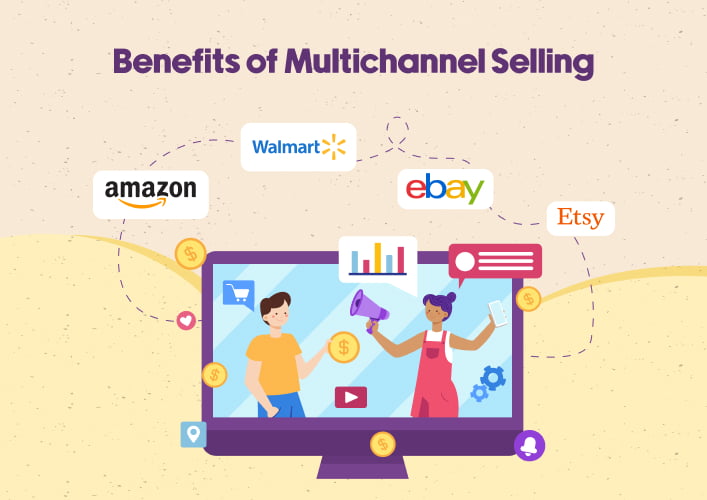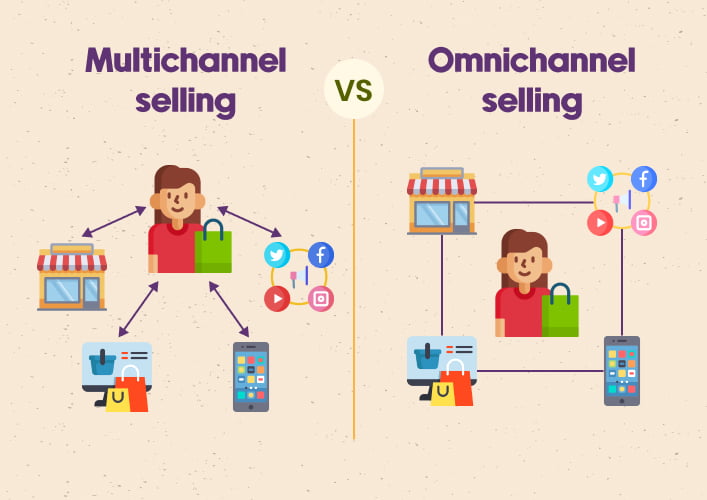Introduction Multichannel Selling
Multichannel selling refers to the practice of making your items available for purchase across a number of different online marketplaces. In this setup, you sell via a mix of online and offline channels, such as your own website, eCommerce marketplaces, mobile applications, and a physical shop.
Using many online sales channels, consumers benefit from a wider selection of products and services. When merchants have a firm grasp on the concept of multichannel sales, they are better positioned to capitalize on sales possibilities that arise outside of their primary channel. It is expected that in 2023, 45.6% of e-commerce sales will be multichannel sales.
Benefits of Multichannel Selling

Multichannel marketing is widely embraced by small and medium-sized businesses. It is because of expanding their customer base and generating more revenue. There are many advantages to using many sales channels, but these are some of the most important ones to keep in mind.
- Customers’ preferences on how and where they like to shop may be met by multichannel retailers. Regional and demographic differences in consumer taste might be significant. Making connections with potential customers is part of your job as a company owner. If a company doesn’t optimize its website for mobile users, it could turn off visitors that perform most of its purchasing on mobile devices.
- Many buyers need to see a product many times before they purchase it. Furthermore, a customer’s interest in a product could be raised by a social media ad. They are more likely to make a purchase after seeing it in more than one store. A customer’s buying mood might change at any time. Having a presence across various channels removes the need for such guesswork.
- You don’t have to worry about marketing by multichannel selling. For example, if you are selling products on Amazon, you don’t have to worry about advertising your products. It is true that Etsy, Amazon, and eBay all deduct a fee from the sale price of your item but, it is in exchange for the use of their name in connection with your goods.
Tips to increase sales with Multichannel Selling
- Keep concentration on your own platform before considering expansion. When you own your own online store, you may choose exactly how the transaction is handled and how the buyer is treated. If you’re doing well completing orders via your own website, you may want to try Amazon, Walmart, and traditional brick-and-mortar shops.
- When a company takes on more markets than it can effectively serve, it risks falling behind on order processing and customer care. Large retailers like Amazon and Walmart have huge client bases, but their order fulfillment requirements may be challenging for smaller companies to achieve. While it could be appealing to put your items on multiple marketplaces, it’s better to start small and build up from there.
- Consistency should be a goal. When a company maintains a consistent brand presence throughout numerous marketplaces, consumers know they will get the same low-pricing, high-quality goods, and services regardless of where they make their final purchase decision. It is true that you will not have a choice in customizing the UI of the website of other companies. But, you can be clear with product descriptions, quality, pricing and more.
Omnichannel vs Multichannel selling

- The term Multichannel selling describes a method of selling goods to a wide variety of distribution points. In contrast, the goal of Omnichannel selling is to empower customers by providing a unified brand experience across many sales channels.
- The omnichannel strategy is an integration of all possible channels, whereas the multichannel method treats each channel independently.
- In omnichannel, all available channels distribute and coordinate customer-facing content simultaneously. However, in a multichannel setup, data from different channels isn’t synchronized with one another. While the product is the focus of multichannel commerce, the customer is the focus of an omnichannel approach.
- With the support of omnichannel selling, you can link important consumer data for better decision-making across all channels. The multichannel approach makes it easier for the marketer to connect the dots between the relevant data about the company that might guide strategic choices. While omnichannel focuses on convenience for the consumer, multichannel centres on meaningful interaction with the brand.
Conclusion
To stay ahead of the competition, businesses should use many sales channels. In order to apply multichannel selling effectively, you must determine which mediums your target audience most often utilizes. Thereafter, ensure that your brand messaging and consumer experience remain uniform across all channels. If you are still having trouble generating the revenue your company desires, book a FREE consultation with our e-commerce experts.
FAQs
What is multichannel selling?
What is omnichannel selling?
How do you do multi-channel marketing?
What is the main benefit of multichannel marketing?
On which platform to sell for multichannel marketing?
Ravi Bhojani is the Chief Marketing Officer (CMO) at Alian Software, where he spearheads the company’s marketing strategies and drives its brand presence in the competitive IT services landscape. With over a decade of experience in the technology and marketing sectors, Ravi has consistently demonstrated his ability to blend innovative marketing techniques with deep industry knowledge to deliver outstanding results.